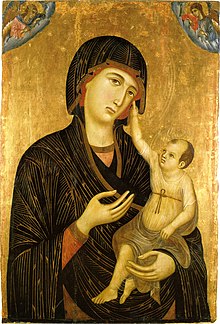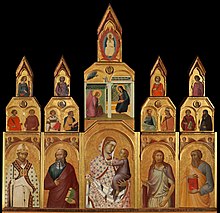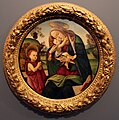Tempera

Tempera(Italian:[ˈtɛmpera]), also known asegg tempera,is a permanent, fast-drying painting medium consisting ofpigmentsmixed with a water-solublebindermedium, usually glutinous material such as eggyolk.Temperaalso refers to the paintings done in this medium. Tempera paintings are very long-lasting, and examples from the first century AD still exist. Egg tempera was a primary method of painting until after 1500 when it was superseded byoil painting.A paint consisting of pigment and binder commonly used in the United States asposter paintis also often referred to as "tempera paint", although the binders in this paint are different from traditional tempera paint.
Etymology[edit]
The termtemperais derived from theItaliandipingere a tempera( "paint indistemper"), from theLate Latindistemperare( "mix thoroughly" ).[1]
History[edit]

Tempera painting has been found onearly Egyptiansarcophagusdecorations. Many of theFayum mummy portraitsuse tempera, sometimes in combination withencaustic paintingwith melted wax, the alternative painting technique in the ancient world. It was also used for the murals of the 3rd centuryDura-Europos synagogue.
A related technique has been used also in ancient and early medieval paintings found in several caves and rock-cut temples of India.[2]High-quality art with the help of tempera was created inBagh Cavesbetween the late 4th and 10th centuries and in the 7th century in Ravan Chhaya rock shelter, Odisha.[3]
Theart techniquewas known from the classical world, where it appears to have taken over fromencaustic painting[citation needed]and was the main medium used forpanel paintingandilluminated manuscriptsin theByzantineworld andMedievalandEarly RenaissanceEurope. Tempera painting was the primary panel painting medium for nearly every painter in the European Medieval and Early renaissance period up to 1500. For example, most surviving panel paintings attributed toMichelangeloare executed in egg tempera, an exception being hisDoni Tondowhich uses both tempera and oil paint.
Oil paint,which may have originated inAfghanistanbetween the 5th and 9th centuries[4]and migrated westward in the Middle Ages[5]eventually superseded tempera. Oil replaced tempera as the principal medium used for creating artwork during the 15th century inEarly Netherlandish paintingin northern Europe. Around 1500, oil paint replaced tempera in Italy. In the 19th and 20th centuries, there were intermittent revivals of tempera technique in Western art, among thePre-Raphaelites,Social Realists,and others. Tempera painting continues to be used in Greece and Russia where it is the traditional medium forOrthodoxicons.
Technique[edit]
Tempera is traditionally created by hand-grinding dry powderedpigmentsinto abinding agentormedium,such as egg yolk, milk (in the form ofcasein) and a variety of plant gums.
Egg tempera[edit]
The most common form of classical tempera painting is "egg tempera". For this form most often only the contents of theegg yolkis used. Thewhite of the eggand the membrane of the yolk are discarded (the membrane of the yolk is dangled over a receptacle and punctured to drain off the liquid inside). The egg yolk is diluted with water and used with pigment. Some kind of remedy is always added in different proportions. One recipe uses vinegar as a preservative, but only in small quantities. A few drops of vinegar will keep the solution for a week. Some egg tempera schools use different mixtures of egg yolk and water, usually the ratio of yolk to water is 1:3; other recipes offer white wine (1 part yolk, 2 parts wine).
Powdered pigment, or pigment that has been ground in distilled water, is placed onto a palette or bowl and mixed with a roughly equal volume of the binder.[6]Some pigments require slightly more binder, some require less.
When used to paint icons on church walls, liquidmyrrhis sometimes added to the mixture to give the paint a pleasing odor, particularly as worshippers may find the egg tempera somewhat pungent for quite some time after completion. The paint mixture has to be constantly adjusted to maintain a balance between a "greasy" and "watery" consistency by adjusting the amount of water and yolk. As tempera dries, the artist will add more water to preserve the consistency and to balance the thickening of the yolk on contact with air. Once prepared, the paint cannot be stored. Egg tempera is water-resistant, but not waterproof. Different preparations use the egg white or the whole egg for a different effect. Other additives such as oil andwax emulsionscan modify the medium. Egg tempera is not a flexible paint and requires stiff boards; painting oncanvaswill cause cracks to form and chips of paint to fall off.
Egg tempera paint should be cured for at least 3 months, up to 6 months. The surface is susceptible to scratches during the curing process, but will become much more durable after curing. Egg tempera paintings are not normally framed behind glass, as the glass can trap moisture and lead to the growth of mold.[7]
Tempera grassa[edit]
Adding oil in no more than a 1:1 ratio with the egg yolk by volume produces a water-soluble medium with many of the color effects of oil paint, although it cannot be painted thickly.
Pigments[edit]
Some of the pigments used by medieval painters, such ascinnabar(contains mercury),orpiment(contains arsenic), orlead white(contains lead) are highly toxic. Most artists today use modern synthetic pigments, which are less toxic but have similarcolorproperties to the older pigments. Even so, many (if not most) modern pigments are still dangerous unless certain precautions are taken; these include keeping pigments wet in storage to avoid breathing their dust.
Application[edit]
Tempera paint dries rapidly. It is normally applied in thin, semi-opaque or transparent layers. Tempera painting allows for great precision when used with traditional techniques that require the application of numerous small brush strokes applied in across-hatchingtechnique. When dry, it produces a smoothmattefinish. Because it cannot be applied in thick layers as oil paints can, tempera paintings rarely have the deep colorsaturationthat oil paintings can achieve because it can hold less pigment (lower pigment load). In this respect, the colors of an unvarnished tempera painting resemble apastel,although the color deepens if avarnishis applied. On the other hand, tempera colors do not change over time,[8]whereas oil paints darken, yellow, and become transparent with age.[9]
Ground[edit]

Tempera adheres best to an absorbentgroundthat has a lower oil content than the tempera binder used (the traditional rule of thumb is"fat over lean",and never the other way around).[10][11]The ground traditionally used is inflexible Italiangesso,and the substrate is usually rigid as well.[12]Historically wood panels were used as the substrate, and more recently un-temperedmasoniteormedium density fiberboard(MDF) have been employed; heavy paper is also used.
Pre-made paints[edit]
Apart from the traditional process of mi xing pigment with egg yolk, new methods include egg tempera sold in tubes by manufacturers such as Sennelier and Daler-Rowney. These paints do contain a slight amount of oil to enhance durability within the container. Notable egg tempera artist and author Koo Schadler points out that because of this addition of oil "tubed 'egg tempera' paints are actually 'tempera grassa', an emulsion of egg yolk and a drying oil (generally with other additives, such as preservatives and stabilizers). Tempera grassa has some of the working properties of both egg tempera and oil painting and is a perfectly viable medium – however it is not the same as pure, homemade egg tempera and behaves differently."[13]Marc Chagallused Sennelier egg tempera tube paints extensively.
Artists[edit]
Although tempera has been out of favor since the Late Renaissance andBaroqueeras, it has been periodically rediscovered by later artists such asWilliam Blake,theNazarenes,thePre-Raphaelites,andJoseph Southall.The 20th century saw a significant revival of tempera. European painters who worked with tempera includeGiorgio de Chirico,Otto Dix,Eliot Hodgkin,Pyke Koch,[14]andPietro Annigoni,who used an emulsion of egg yolks, stand oil and varnish.
Spanish surrealist painterRemedios Varoworked extensively in egg tempera.
Revival in 20th-century American art[edit]
The tempera medium was used by American artists such as theRegionalistsAndrew Wyeth,Thomas Hart Bentonand his studentsJames Duard MarshallandRoger Medearis;expressionistsBen Shahn,Mitchell SiporinandJohn Langley Howard,magic realistsGeorge Tooker,Paul Cadmus,Jared French,Julia Theclaand Louise E. Marianetti, realist painterDavid Hanna;Art Students League of New YorkinstructorsKenneth Hayes MillerandWilliam C. Palmer,Social RealistsKyra Markham,Isabel Bishop,Reginald Marsh,andNoel Rockmore,Edward Laning,Anton Refregier,Jacob Lawrence,Rudolph F. Zallinger,Robert Vickrey,Peter Hurd,andscience fictionartistJohn Schoenherr,notable as the cover artist ofDune.
20th-century Indian art[edit]
In the early part of the 20th century, a large number of Indian artists, notably of theBengal schooltook up tempera as one of their primary media of expression. Artists such asGaganendranath Tagore,Asit Kumar Haldar,Abanindranath Tagore,Nandalal Bose,Kalipada GhoshalandSughra Rababiwere foremost. After the 1950s, artists such asJamini RoyandGanesh Pyneestablished tempera as a medium for the new age artists of India.
In contemporary art[edit]
Other practicing tempera artists includePhilip Aziz,Ernst Fuchs,Antonio Roybal,George Huszar,Donald Jackson,Tim Lowly,Altoon Sultan,Shaul Shats,Sandro Chia,Alex Colville,Robert Vickrey,Andrew Wyeth,Andrew Grassie,Soheila Sokhanvari,andGanesh Pyne.
Gallery[edit]
-
Spanish,Altar Frontal with Christ in Majesty and the Life of Saint Martin,1250,The Walters Art Museum
-
Guido da Siena,Madonna,Church of San Regolo, Siena, tempera and gold on panel, 1285–1295
-
Duccio,Madonna and Child with saintspolyptych,tempera and gold on wood, 1311–1318
-
Bernardo Daddi,Christ Enthroned with Saints Sebastian, Leo, Alexander, Peregrine, Philip, Rufianiaus, Justa, Concordius and Decentius,14th century
-
Sassetta,detail ofVirgin and Child with Four Saints,tempera on wood, 1435
-
Sandro Botticelli,tempera on panel, 1490–1500
-
Antonio da Fabriano,Saint Jerome in His Study,1451,The Walters Art Museum
-
Marianne Stokes,Melisande,tempera on canvas, 1895–1898
See also[edit]
References[edit]
- ^Cerasuolo, Angela (10 January 2017).Literature and Artistic Practice in Sixteenth-Century Italy.BRILL.ISBN9789004335349– via Google Books.
- ^"Ancient and medieval Indian cave paintings – Internet encyclopedia, Wondermondo, June 10, 2010".Wondermondo. 2010-06-04.Retrieved2012-07-29.
- ^"Ravan Chhaya rock shelter near Sitabinji, Wondermondo, May 23, 2010".Wondermondo. 2010-05-23.Retrieved2012-07-29.
- ^"World's oldest oil paintings in Afghanistan".Reuters. 2008-04-22.Retrieved2012-07-29.
- ^Theophilus mentions oil media in the 12th Century
- ^Mayer, Ralph, 1976.The Artist's Handbook of Materials and Techniques(3rd ed.). New York: Viking Penguin Inc., p. 228.
- ^"Egg Tempera Misconceptions - Egg Tempera Forums".eggtempera.Retrieved2023-01-29.
- ^Mayer, Ralph, 1985.The Artist's Handbook of Materials and Techniques(4th ed.). New York: Viking Penguin Inc., p. 215
- ^Mayer, 1985, p. 119
- ^Doerner, Max, 1946.The Materials of the Artist and Their Use in Painting.New York: Harcourt, Brace and Company. p. 230.
- ^Mayer, Ralph, 1976.The Artist's Handbook of Materials and Techniques(3rd ed.). New York: Viking Penguin Inc., pp. 165, 253.
- ^Mayer, 1976, p. 269.
- ^Schadler, Koo (2017-07-18)."History of Egg Tempera Painting"(PDF).
- ^"Zelfportret met zwarte band (1937)".Centraal Museum (Utrecht)(in Dutch).
Further reading[edit]
- Altoon Sultan,The Luminous Brush: Painting With Egg Tempera,Watson-Guptill Publications, New York 1999.
- Richard J. Boyle, Richard Newman, Hilton Brown: Milk and Eggs: The American Revival of Tempera Painting, 1930–1950 Brandywine River Museum Staff, Akron Art Museum StaffISBN0295981903(0-295-98190-3) Softcover, University of Washington Press
- Lara Broecke,'Cennino Cennini'sIl Libro dell'Arte:a New English Translation and Commentary with Italian Transcription', Archetype Publications 2015.ISBN978-190-949-228-8
- Daniel V. Thompson, Jr.,Materials and Techniques of Medieval Painting,Dover: explanation and expansion on Cennini's works
- Daniel V. Thompson, Jr.The Practice of Tempera Painting: Materials and Methods,Dover Publications, Inc. 1962.
- Chifan C. Alexandru, "Symbol of hand in fine arts", Artes Publication 2013, Iaşi, Romania,ISBN978-606-547-100-9











